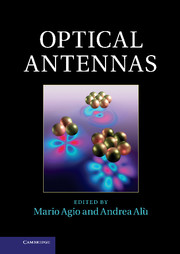Book contents
- Frontmatter
- Contents
- Preface
- List of contributors
- Notation
- Part I FUNDAMENTALS
- Part II MODELING, DESIGN AND CHARACTERIZATION
- Part III APPLICATIONS
- 18 Optical antennas for information technology and energy harvesting
- 19 Nanoantennas for refractive-index sensing
- 20 Nanoimaging with optical antennas
- 21 Aperture optical antennas
- References
- Index
20 - Nanoimaging with optical antennas
from Part III - APPLICATIONS
Published online by Cambridge University Press: 05 March 2013
- Frontmatter
- Contents
- Preface
- List of contributors
- Notation
- Part I FUNDAMENTALS
- Part II MODELING, DESIGN AND CHARACTERIZATION
- Part III APPLICATIONS
- 18 Optical antennas for information technology and energy harvesting
- 19 Nanoantennas for refractive-index sensing
- 20 Nanoimaging with optical antennas
- 21 Aperture optical antennas
- References
- Index
Summary
Introduction
The oldest form of imaging is optical imaging, which has been an inseparable part of human life for centuries. People have used flat or curved surfaces of solids and liquids as mirrors and lenses to form several kinds of images for a long time. Naturally, the light utilized in such imaging was the light that we could see, which means the visible spectral range of light. Nature has many interesting things to offer – one of them is the fact that visible light (from near-UV to near-IR) contains an energy that is comparable to the electronic or vibrational energies of most of the naturally existing materials that we interact with in our day-to-day lives. Visible light can therefore interact directly with the electronic or vibronic system of a sample, and can extract information related to the intrinsic properties of the sample. Thus, optical imaging turns out to be the most informative technique, which has gradually improved over time as scientists have developed various kinds of microscopes and telescopes that have enabled us to see tiny objects, such as bacteria, or distant objects, such as planets.
Even though the visible region is the best spectral range of light for informative imaging, it turns out that the rather longer wavelengths associated with this range of light makes it impossible for visible light to interact efficiently with nanomaterials. Thus, even with the fast and remarkable progress of optical imaging techniques, observing a sample at nanoscale resolution with an optical microscope has always remained a dream for scientists.
- Type
- Chapter
- Information
- Optical Antennas , pp. 356 - 368Publisher: Cambridge University PressPrint publication year: 2013



